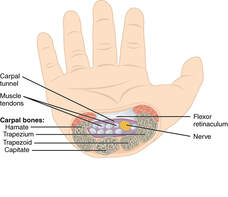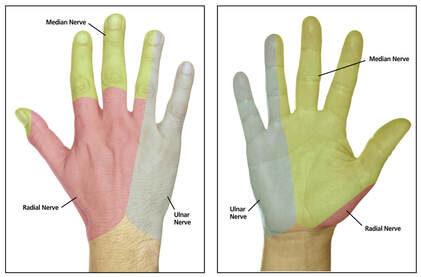|
-- By Erica Sastre, LMT  YES Understanding Carpal Tunnel: Carpal tunnel syndrome is characterized by numbness, tingling, or pain in the hands (particularly the thumb, index finger, middle finger and the thumb side of the ring finger, as this is the part of the hand innervated by the median nerve). The irritation or pain can also refer up the arm, affecting more than just the hand and wrist. The onset might be during sleep, after prolonged activity, or seemingly random. Persistence or recurrence of these symptoms should definitely be addressed! Un-addressed carpal tunnel will lead to a steady increase in these symptoms, and eventually weakness and atrophy of the hands. True Carpal Tunnel is an irritation of the median nerve at the transverse carpal ligament. Carpal tunnel affects about 1 in 10 people, making it the most common nerve compression syndrome! Carpal tunnel syndrome often affects, machinists, hairdressers, musicians, massage therapists, even chiropractors! Anyone making prolonged repetitive use of their hands, fingers and wrists. Now that everyone is texting and typing as much as typists used to when this syndrome was identified... It can really affect anyone.  Understanding Nerve Compression Syndromes: When you have symptoms of numbness or tingling, this usually indicates a nerve problem. Nerves run from the spine throughout the body to give us sensation and feeling, giving our brains vital information about the world around us. When a nerve is compressed or pinched, it interferes with these signals. This is what happens when your arm or foot falls asleep after sitting on it for a long time. Except with carpal tunnel you can’t quite shake it out the way you can a sleeping foot. The more frequent and persistent numbness and tingling become the more severe the problem is. Carpal Tunnel Syndrome specifically compresses the median nerve at the wrist. There are other syndromes that have the same symptoms as carpal tunnel, for example, the median nerve can be compressed at the elbow such as in pronator teres syndrome, or at the shoulder such as in thoracic outlet syndrome, or in the neck due to a subluxation or misalignment in the cervical spine. That is why it is important to get a proper diagnosis for your symptoms. There have been many cases of patients receiving surgery for carpal tunnel but, the surgery did noting for their symptoms as they actually had one of these other conditions. What's happening in the 'tunnel'? The transverse carpal ligament is a round band of fascia that hold the flexor muscles in place. Imagine a rubbery calamari ring in your wrist, and that your muscles and nerves are strands of spaghetti strands are running through it! (Are you hungry yet?) The wrist is a high traffic area! You’ve got carpal bones, you’ve got the tendons of the flexor muscles, you’ve got the median nerve… When this area gets over-crowded the other tissues in the space will compress the median nerve and cause these symptoms. There are several things that can cause a jam-up in this area include edema, subluxation of a carpal bone, fascial adhesion, inflammation of the flexor muscle tendons, and inflammation of the transverse carpal ligament itself. How can this condition be treated? Manual therapy can be really effective in treating carpal tunnel. Calming the overworked tissues, reducing inflammation, breaking fascia and adhesions, and reducing pain. Massage, acupuncture, chiropractic adjustment of the wrist, stretches and exercises, using a wrist brace to splint the wrist, resting the wrist, cortisol shots, and even surgery are all options. Should I get evaluated for carpal tunnel? You can give yourself the following simple tests: If any of the above exercises causes numbness, tingling, or pain in the hands, make an appointment to get checked for carpal tunnel.
Fun Facts:
That's a wrap for our blog this week! We hoped you learned a little more about this common condition. Stay tuned for our next blog, and send your questions to norwalksporstandspine@gmail.com
2 Comments
5/26/2022 01:22:37 am
While most of the people may think that carpal tunnel syndrome (CTS) to be the neglected cause of any pain, insensitivity, itchy, or weakness in the hand and/or wrist, the situation is more complicated. In certain cases, a patient with such signs may not have CTS at all. So when a patient comes into the office to be assessed for CTS, how does their doctor of chiropractic decide if CTS is the victim and how is the situation handled? When median nerve entrapment is implicated, a doctor of chiropractic will test the whole length of the nerve to recognize all feasible problems that should be handled. If the presenting attributes are musculoskeletal in nature, then treatment may comprise of manipulation, mobilization, soft tissue work, techniques, nocturnal binding, workstation changes, stretches, and at-home work out to lessen the pressure on and enhancement in the agility of the median nerve. Modifications in hormone levels can also create swelling of tissues that enclose the median nerve. In which case, control with the patient’s physician may be needed to attain an optimal result.
Reply
Leave a Reply. |
The Norwalk Sports & Spine Blog is for answering your questions! Stay tuned to learn about our practice, health, food, treatments, and more!Subscribe for updates! Categories
All
Archives
September 2019
|


 RSS Feed
RSS Feed